How to Compare Two Drives for Duplicate Files: Step-By-Step Guide
 442
442
 0
0

Duplicate Finder
Compare Drives for Duplicate Files
You might have the same files stored on two or more drives for various reasons. For example, some users like to transfer files to external hard drives or sync files with cloud drives. In the process, it's easy to creating a large number of duplicate files.
Manually comparing and finding duplicate files across two drives can be time-consuming. In this article, I’ll introduce two more efficient methods. The one is using a dedicated duplicate file finder, and the other is using your computer’s built-in file manager.
Part 1. How to compare two drives for duplicate files with Cisdem Duplicate Finder?
This part is about how to compare two drives (computer drives, external hard drives, cloud drives) for duplicate files quickly and clearly with Cisdem Duplicate Finder.
Cisdem Duplicate Finder is a powerful tool that can detect duplicate files - including photos, audio files, videos, documents, and even similar photos. It can scan and compare multiple drives or folders at once. When scanning two or more drives, you can specify a prioritized location from which duplicates will be deleted first.
It supports finding duplicate files on computer drives, folders, external hard drives, SD cards, cloud drives, and more. You can also compare these locations to identify duplicates. Here are three common situations.
Scenario 1. Compare a computer drive and an external hard drive
“I love photography. I've been storing my daily photos on my computer's D: drive and an external hard drive. Yesterday, I found a lot of duplicate photos. They exist on two drives. I want to free up some space on my computer. I’m looking for a way to compare drives for duplicate files and prioritize deleting duplicates from my D: drive. How can I do this?”
Step 1. Connect your external hard drive to your computer by plugging the other end of the USB to computer's USB port.
Step 2. Download and install Cisdem Duplicate Finder on your computer.
 Free Download Windows 10 or later
Free Download Windows 10 or later  Free Download macOS 10.11 or later
Free Download macOS 10.11 or later
Step 3. Launch the program. Click Settings. Click the Duplicate files tab.
Under Select duplicates for removal following preset rules below, choose the last option: Select duplicates for removal from prioritized location.
Click Add under the box. Add both the D: drive and your external hard drive.
Set priority values: since you want duplicates to be removed from the D: drive first, set D: drive to 2 and your external hard drive to 1 (lower than 2).
Click OK.
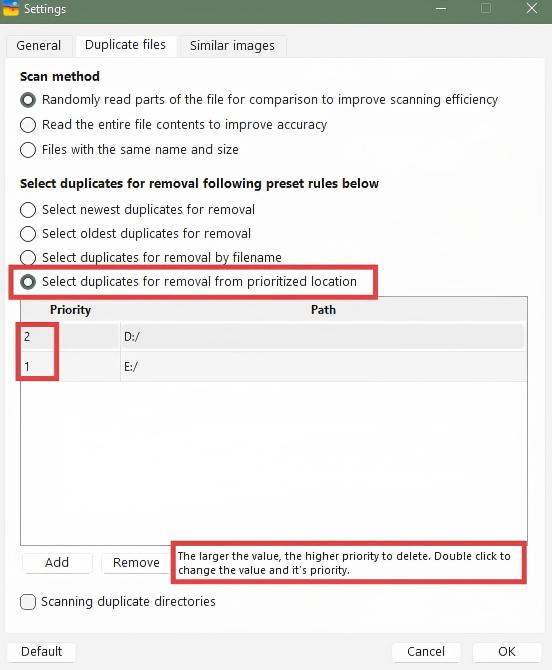
Step 4. Go back to the main window of this program. Click the plus icon. Add both the D: drive and your external hard drive. Click Scan.
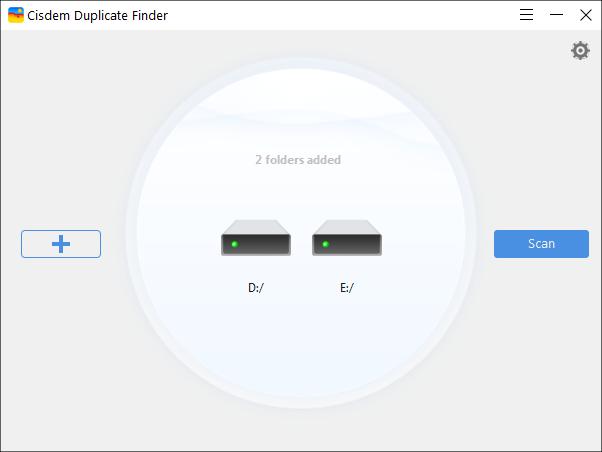
Step 5. Wait for it to complete the scan. Now you can preview the detected duplicate files in the results window. To preview duplicate photos, go to the Image tab.
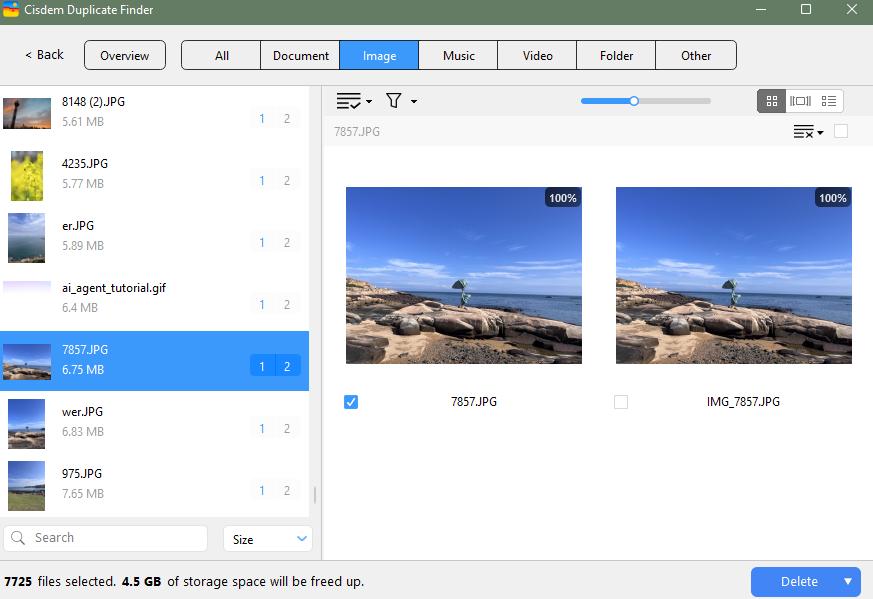
It offers three preview modes, letting you compare duplicate files side by side or view detailed information.
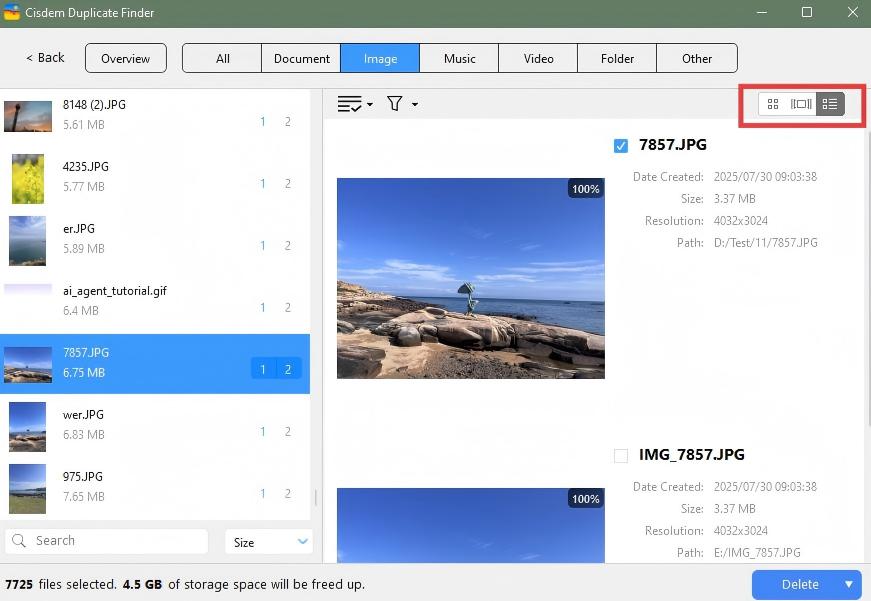
Step 6. Cisdem Duplicate Finder will automatically select all but one file in each group of duplicates for remover. Based on your settings in step 3, it will prioritize selecting duplicates from the D: drive.
Click Delete to remove the duplicate files across your computer drive and external hard drive.
Click Yes to confirm the remover.

Scenario 2. Compare a computer drive and a cloud drive
"I use Dropbox to back up all important documents from my computer’s D: drive. Some files exist both on my computer and Dropbox. They’re taking up extra space. I want to compare two drives for duplicate files and remove the exact duplicate files. How to do this?"
Step 1. If you haven’t installed the Dropbox desktop app, go to dropbox.com/install. Download and install it on your computer.
Click Sign in with Dropbox. Log in to your account.
Click Advanced settings. Deselect Save files as online only. Click Down.
Wait for the sync to finish. Then you’ll see the “Your files are up to date” message. You are able to access Dropbox in File Explorer on Windows or in Finder on Mac.
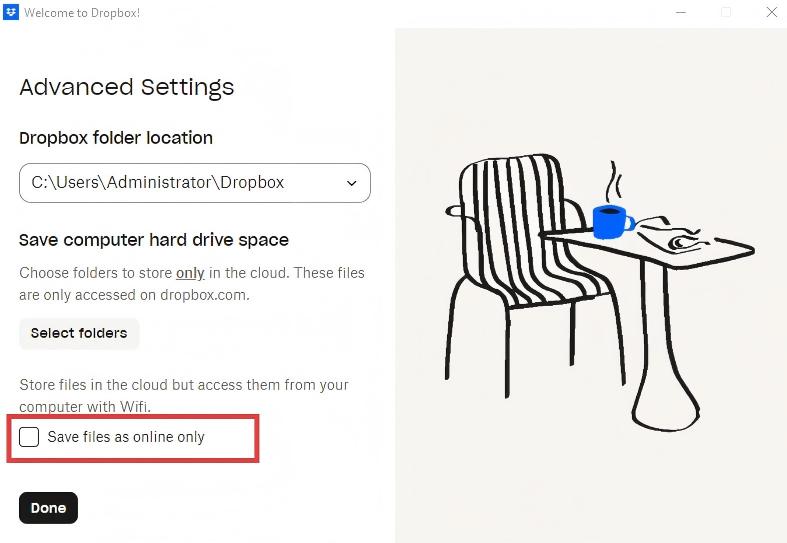
Step 2. Download and install Cisdem Duplicate Finder.
Step 3. Open it. Add both your computer’s D: Drive and Dropbox into the program. Click Scan.
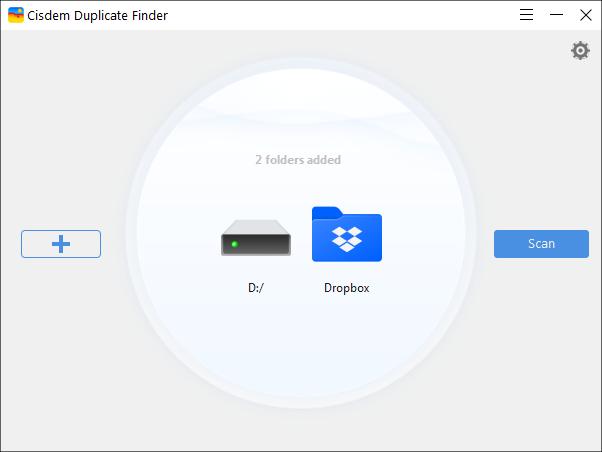
Step 4. In the results window, go to the Document tab to preview all detected duplicate documents from your D: drive and Dropbox.
You can compare the file name, creation date, or path to select duplicates for remover. It also provides selection rules to help you mass select.
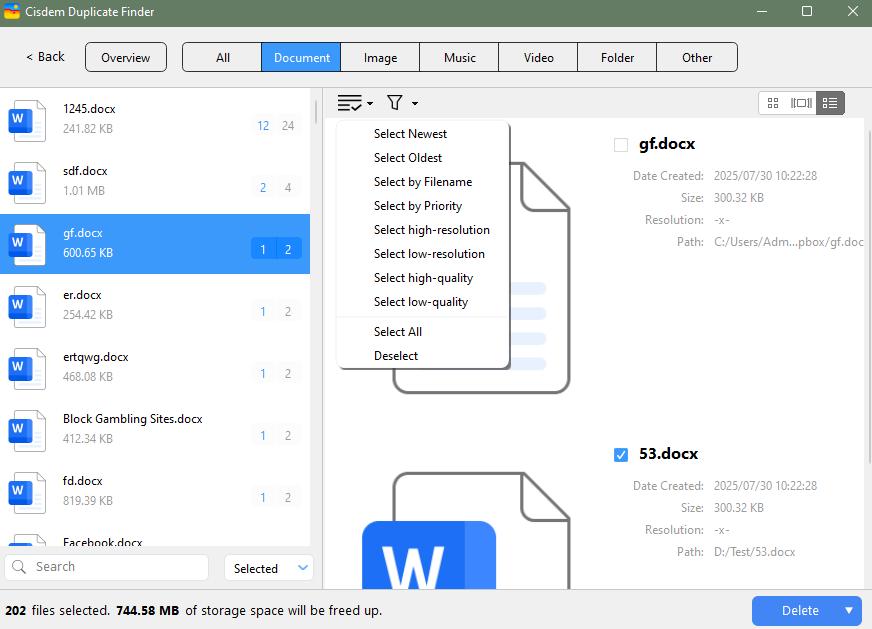
Step 5. Click Delete in the bottom right corner. Then confirm by clicking Yes.
When deleting files from Dropbox, a window will pop up asking if you want to delete the items from your Dropbox account and all devices. Click Delete everywhere.
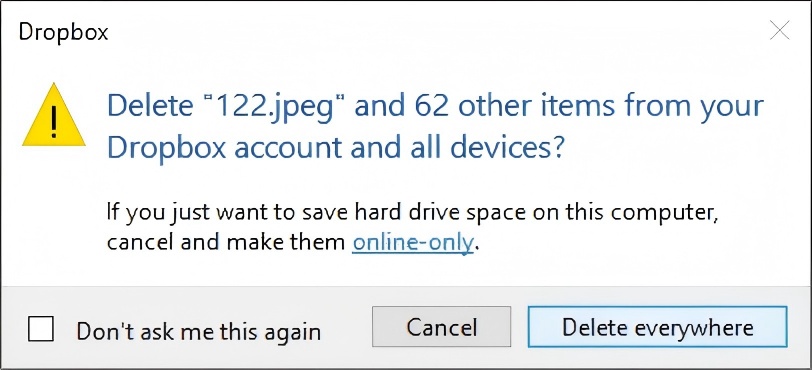
Tip: Cisdem Duplicate Finder also supports detecting duplicate files in Google Drive and OneDrive, as well as comparing duplicates between them.
Scenario 3. Compare two external hard drives
"I have two external hard drives to store my music collection. One is my main backup drive that I use regularly, and the other is an older drive that I used years ago. A few days ago, I noticed that some of the same audio files were stored in both drives. I want to compare the two drives for duplicates and remove files from the older drive. I tried doing this manually but it was woo time-consuming. Is there a quicker way?"
Step 1. Connect the two external hard drives to your Windows PC or Mac.
Step 2. Download and install Cisdem Duplicate Finder.
Step 3. Open the program. Click the Settings icon in the upper right corner.
Click Duplicate files. Choose the option of Select duplicates for remover from prioritized location. Set a higher priority value for the older drive from which you want to delete duplicate files.
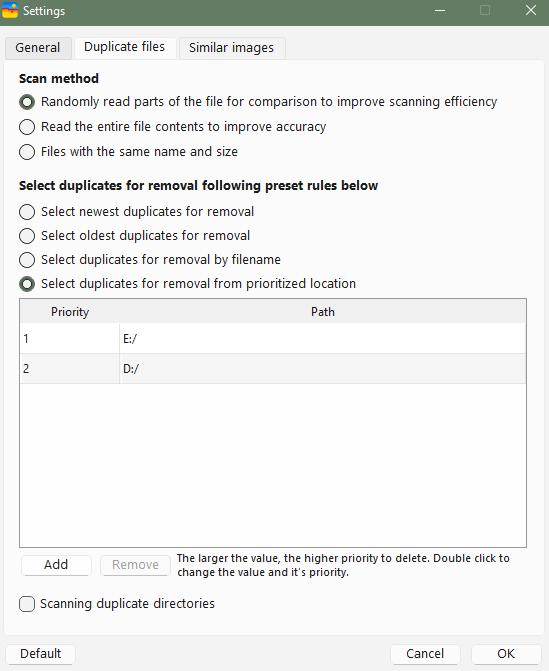
Click General. Here, you are allowed to set the minimum and maximum file sizes to scan. You can also exclude specific files, folders, or file formats from the scan.
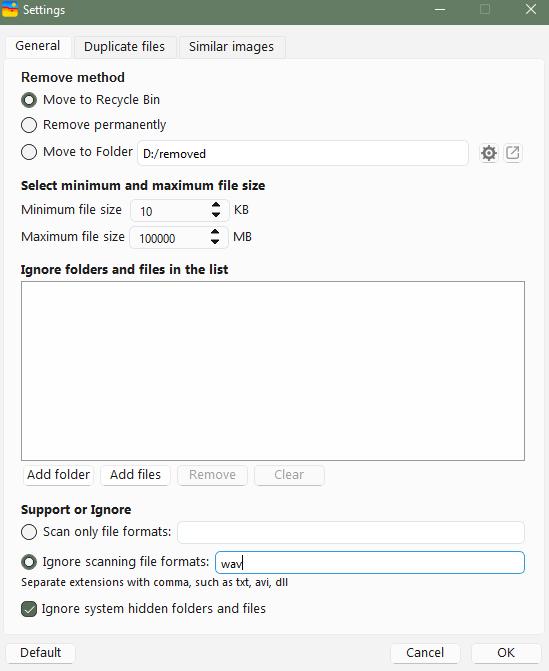
Click OK.
Step 4. Click the plus icon on the main window. Add your two drives into the program. Click Scan.
Step 5. It scans fast. You can view the detected duplicate files in the pop-up results window.
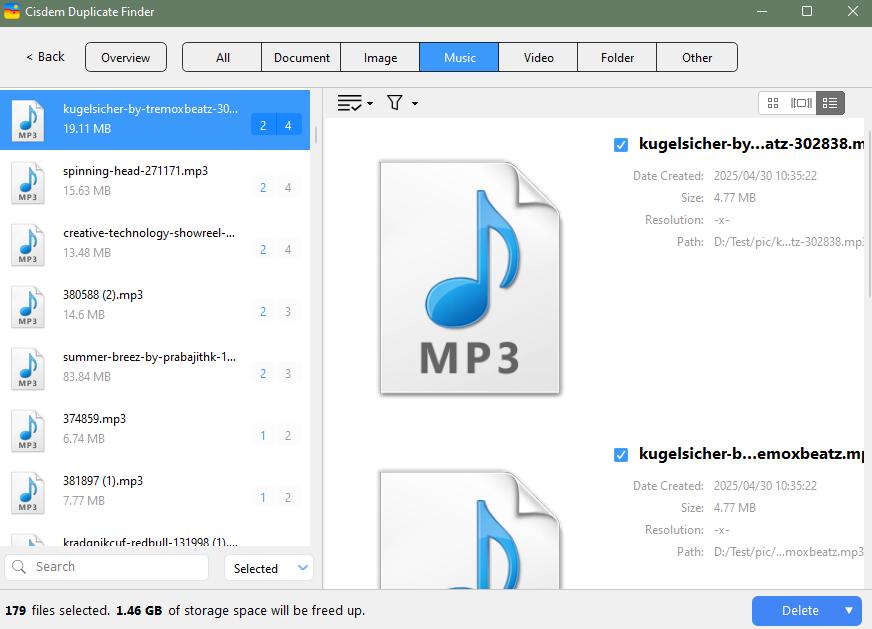
Step 6. Click Delete. Click Yes to remove all duplicate audio files from your older drive.
Part 2. How to compare two drives for duplicate files with File Explorer or Finder?
In this part, I’ll tell you how to compare two drives for duplicate files with computer’s built-in file manager. Below are step-by-step instructions for Windows and Mac.
Windows File Explorer
If you have exact duplicate files ( identical in both file name and file size) on two drives, Windows File Explorer can help you locate and remove many of them without installing extra software.
Step 1. If you want to compare external hard drives, first connect the drives to PC.
Step 2. Open two File Explorer windows.
Step 3. In the first window, open Drive A (e.g., D:). In the second window, open Drive B (e.g., E:).
Step 4. Click View > Details in both windows.
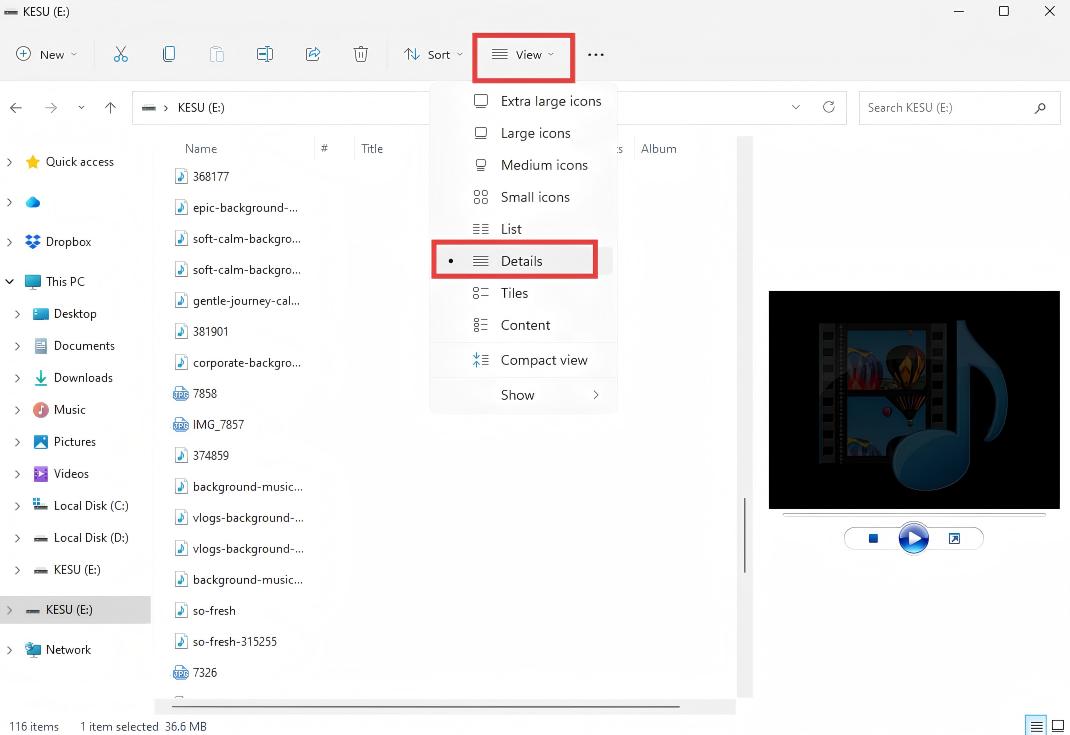
Step 5. Click Sort > Group by > Name or Size in both windows.
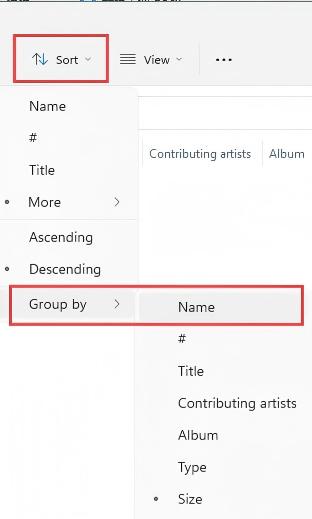
Step 6. In the search box, you can type kind:=picture, kind:=music, or kind:=document to filter files by type.
Or filter by extension, such as type jpg, mp3, or mp4.
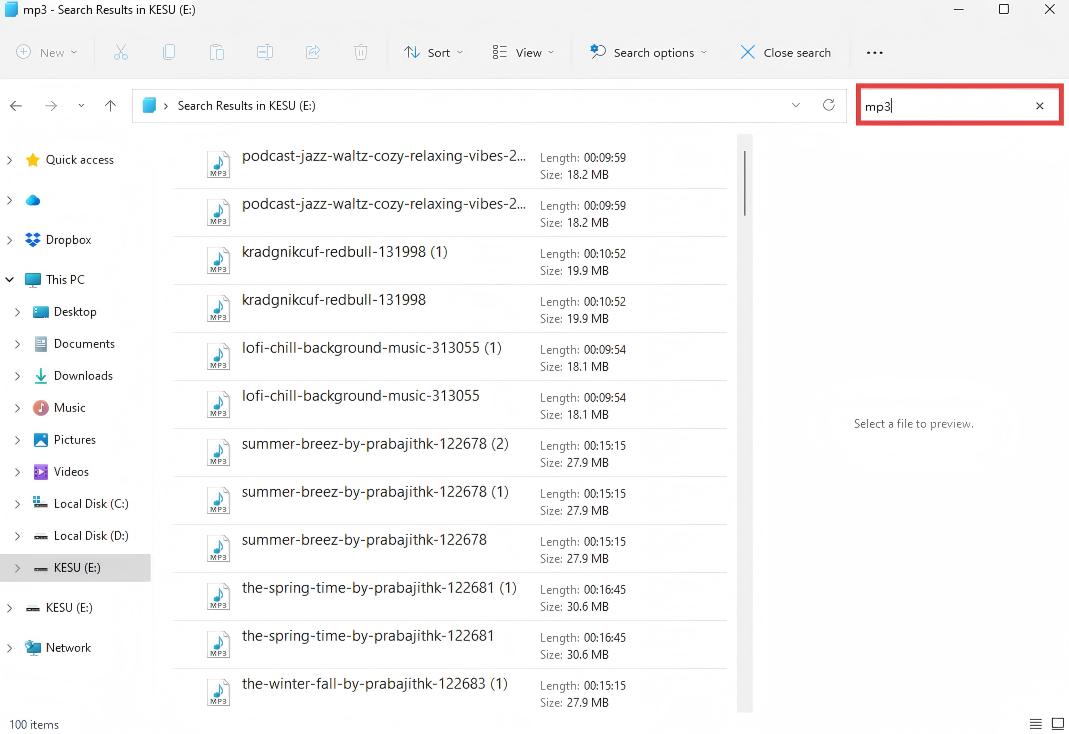
Step 7. Preview and compare files in two windows. Manually select files with the same names and file sizes, which are most likely duplicates. Then right-click and tap the Trash icon to delete them.
Mac Finder
Finder is the default file manager on Mac. Mac users can use it to compare drives for duplicate files with the same filenames and file sizes.
Step 1. First connect the external hard drives to your Mac (if needed).
Step 2. Open two Finder windows.
Step 3. In the first window, open Drive A. In the second window, open Drive B.
Step 4. In each window, open the first drop down menu. Select Kind, and choose a file type such as Image, Document, or Music.
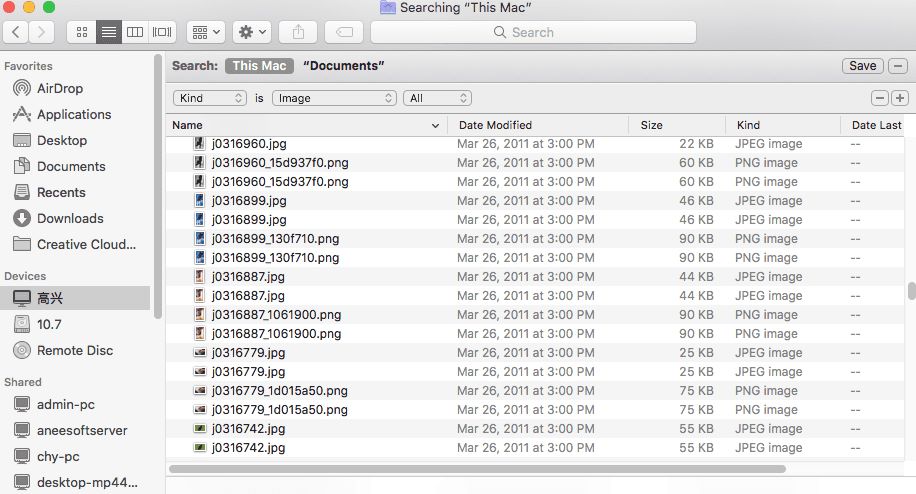
tep 5. Choose the sort order. Click Name or Size in both windows.
Step 6. Preview and compare the file names, file sizes and creation dates, etc. Choose duplicate files you want to delete.
Step 7. Drag them to Trash.
Part 3. Comparison of the two methods
When it comes to comparing two drives for duplicate files, both Cisdem Duplicate Finder and computer’s built-in file manager can get the job done, but they differ greatly in speed, accuracy, and convenience. Below is a comparison of the two methods.
|
Method |
Pros |
Cons |
Best for |
|---|---|---|---|
|
Cisdem Duplicate Finder |
Fast, accurate, side-by-side file comparison; detailed preview; auto-select duplicates; 8 selection rules; 3 removal methods. |
Requires installation. |
Comparing drives with large numbers of files. |
|
File Explorer/Finder |
Free, built-in. |
Time-consuming, easy to miss duplicates, entirely manual process. |
Comparing drives with a small number of files. |
Conclusion
In this article, I’ve covered two ways to compare drives for duplicate files: using a dedicated duplicate file finder and using your computer’s built-in file manager. The first method enables you to compare computer drives, external hard drives, and even cloud drives for duplicates quickly and accurately. I've provided detailed steps for three different scenarios in part 1. If your situation differs from what I've listed, please share them in the comments. I'd love to hear about your

With a passion for tech and writing, Sarah joined Cisdem, where she focuses on creating articles about using utility tools to enhance file management and simplify contact management.

Adrian Li is Cisdem’s Chief Engineer and serves as the editorial advisor for Duplicate Finder and ContactsMate. His work and insights have been featured in leading tech publications such as Fossbytes, TUAW, Redmond Pie, SafetyDetectives, and BestForAndroid.















